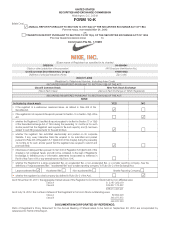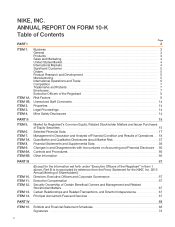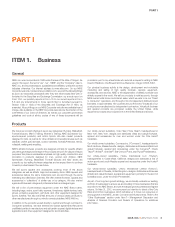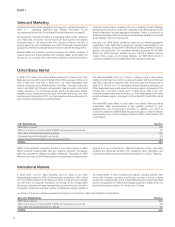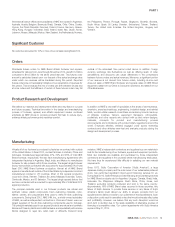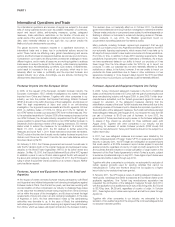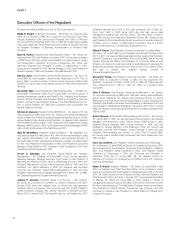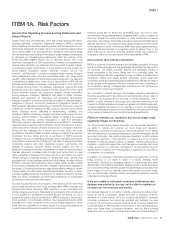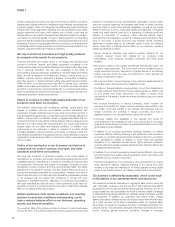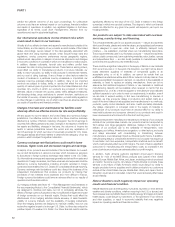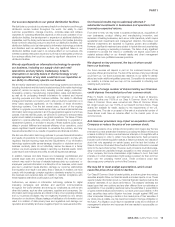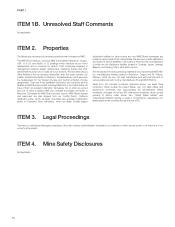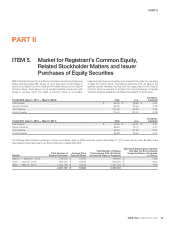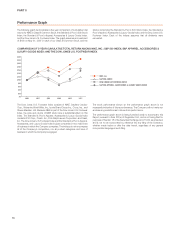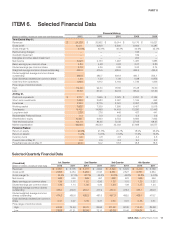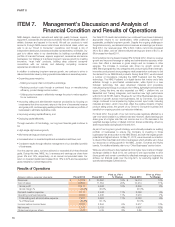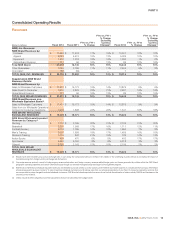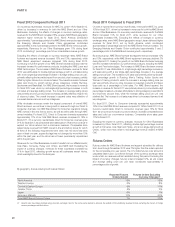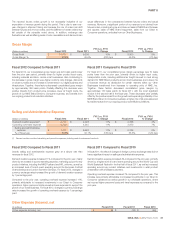Nike 2012 Annual Report Download - page 11
Download and view the complete annual report
Please find page 11 of the 2012 Nike annual report below. You can navigate through the pages in the report by either clicking on the pages listed below, or by using the keyword search tool below to find specific information within the annual report.PART I
preferences, weather conditions, availability of import quotas and currency
exchange rate fluctuations, could adversely affect our business and cause our
results of operations to fluctuate. Our operating margins are also sensitive to a
number of factors that are beyond our control, including manufacturing and
transportation costs, shifts in product sales mix, geographic sales trends, and
currency exchange rate fluctuations, all of which we expect to continue.
Results of operations in any period should not be considered indicative of the
results to be expected for any future period.
“Futures” orders may not be an accurate indication of our
future revenues.
We make substantial use of our “futures” ordering program, which allows
retailers to order five to six months in advance of delivery with the commitment
that their orders will be delivered within a set period of time at a fixed price.
Our futures ordering program allows us to minimize the amount of products
we hold in inventory, purchasing costs, the time necessary to fill customer
orders, and the risk of non-delivery. We report changes in futures orders in our
periodic financial reports. Although we believe futures orders are an important
indicator of our future revenues, reported futures orders are not necessarily
indicative of our expectation of changes in revenues for any future period. This
is because the mix of orders can shift between futures and at-once orders. In
addition, foreign currency exchange rate fluctuations, order cancellations,
shipping timing, returns, and discounts can cause differences in the
comparisons between futures orders and actual revenues. Moreover, a
significant portion of our revenue is not derived from futures orders, including
at-once and close-out sales of NIKE Brand footwear and apparel, sales of
NIKE brand equipment, sales from our Direct to Consumer operations, and
sales from our Other Businesses.
Our “futures” ordering program does not prevent excess
inventories or inventory shortages, which could result in
decreased operating margins and harm to our business.
We purchase products from manufacturers outside of our futures ordering
program and in advance of customer orders, which we hold in inventory and
resell to customers. There is a risk we may be unable to sell excess products
ordered from manufacturers. Inventory levels in excess of customer demand
may result in inventory write-downs, and the sale of excess inventory at
discounted prices could significantly impair our brand image and have an
adverse effect on our operating results and financial condition. Conversely, if
we underestimate consumer demand for our products or if our manufacturers
fail to supply products we require at the time we need them, we may
experience inventory shortages. Inventory shortages might delay shipments
to customers, negatively impact retailer and distributor relationships, and
diminish brand loyalty.
The difficulty in forecasting demand also makes it difficult to estimate our
future results of operations and financial condition from period to period. A
failure to accurately predict the level of demand for our products could
adversely affect our net revenues and net income, and we are unlikely to
forecast such effects with any certainty in advance.
We may be adversely affected by the financial health of our
retailers.
We extend credit to our customers based on an assessment of a customer’s
financial condition, generally without requiring collateral. To assist in the
scheduling of production and the shipping of seasonal products, we offer
customers the ability to place orders five to six months ahead of delivery
under our “futures” ordering program. These advance orders may be
cancelled, and the risk of cancellation may increase when dealing with
financially ailing retailers or retailers struggling with economic uncertainty. In
the past, some customers have experienced financial difficulties, which have
had an adverse effect on our business. As a result, retailers may be more
cautious than usual with orders as a result of weakness in the retail economy.
A slowing economy in our key markets could have an adverse effect on the
financial health of our customers, which in turn could have an adverse effect
on our results of operations and financial condition. In addition, product sales
are dependent in part on high quality merchandising and an appealing store
environment to attract consumers, which requires continuing investments by
retailers. Retailers who experience financial difficulties may fail to make such
investments or delay them, resulting in lower sales and orders for our
products.
Consolidation of retailers or concentration of retail market
share among a few retailers may increase and concentrate
our credit risk, and impair our ability to sell our products.
The athletic footwear, apparel, and equipment retail markets in some
countries are dominated by a few large athletic footwear, apparel, and
equipment retailers with many stores. These retailers have in the past
increased their market share and may continue to do so in the future by
expanding through acquisitions and construction of additional stores. These
situations concentrate our credit risk with a relatively small number of retailers,
and, if any of these retailers were to experience a shortage of liquidity, it would
increase the risk that their outstanding payables to us may not be paid. In
addition, increasing market share concentration among one or a few retailers
in a particular country or region increases the risk that if any one of them
substantially reduces their purchases of our products, we may be unable to
find a sufficient number of other retail outlets for our products to sustain the
same level of sales and revenues.
Failure to adequately protect our intellectual property
rights could adversely affect our business.
We utilize trademarks on nearly all of our products and believe that having
distinctive marks that are readily identifiable is an important factor in creating a
market for our goods, in identifying us, and in distinguishing our goods from
the goods of others. We consider our NIKE®and Swoosh Design®
trademarks to be among our most valuable assets and we have registered
these trademarks in almost 150 jurisdictions. In addition, we own many other
trademarks that we utilize in marketing our products. We believe that our
trademarks, patents, and other intellectual property rights are important to our
brand, our success, and our competitive position. We periodically discover
products that are counterfeit reproductions of our products or that otherwise
infringe on our intellectual property rights. If we are unsuccessful in challenging
a party’s products on the basis of trademark or design or utility patent
infringement, continued sales of these products could adversely affect our
sales and our brand and result in the shift of consumer preference away from
our products.
The actions we take to establish and protect trademarks, patents, and other
intellectual property rights may not be adequate to prevent imitation of our
products by others or to prevent others from seeking to block sales of our
products as violations of proprietary rights. We may be subject to liability if
third parties successfully claim that we infringe their trademarks, patents, or
other intellectual property rights. Defending infringement claims could be
expensive and time-consuming and might result in our entering into costly
license agreements. We also may be subject to significant damages or
injunctions against development and sale of certain products.
In addition, the laws of certain foreign countries may not protect intellectual
property rights to the same extent as the laws of the United States. We may
face significant expenses and liability in connection with the protection of our
intellectual property rights outside the United States, and if we are unable to
successfully protect our rights or resolve intellectual property conflicts with
others, our business or financial condition may be adversely affected.
We are subject to periodic litigation and other regulatory
proceedings, which could result in unexpected expense of
time and resources.
From time to time we are called upon to defend ourselves against lawsuits
and regulatory actions relating to our business. Due to the inherent
uncertainties of litigation and regulatory proceedings, we cannot accurately
NIKE, INC. Š2012 Form 10-K 11

